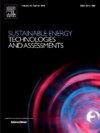Lifetime cost analysis of zero-emission refuse collection vehicles in Scotland
IF 7
2区 工程技术
Q1 ENERGY & FUELS
Sustainable Energy Technologies and Assessments
Pub Date : 2025-05-14
DOI:10.1016/j.seta.2025.104326
引用次数: 0
Abstract
Refuse Collection Vehicles (RCVs) directly affect public health and well-being due to their operation close to residential areas, schools, hospitals, and other public spaces. Transitioning to zero-emission RCV typically requires a strong business case. This paper, therefore, investigates the tank-to-wheel lifetime cost for zero-emission RCVs (Fuel Cell and Battery powertrain) and Internal Combustion Refuse Collection Vehicles (ICRCV) considering the whole waste collection operation, daily driving mileage, type of connection of the hydrogen power plant to the energy source, and social benefits of low emissions for rural and urban environments. Assessments were carried out for a present-day (2023) scenario, and a sensitivity analysis to assess the impact of changing the input parameters on the lifetime cost of both Battery and Fuel Cell RCVs (FRCVSs). Results indicate that when the hydrogen power plant is directly linked to the energy source along with the incorporation of the social cost, the FCRCV demonstrates cost-competitiveness with ICRCV. The lifetime cost of FCRCV is 8.34% lower in urban areas and nearly 20% less in rural areas compared to ICRCV. Additionally, in rural areas, the lifetime cost of FCRCVs is 6.63% lower than that of BRCVs, making FCRCV a cost-competitive choice when the hydrogen power plant is indirectly linked to the energy source, making it a justifiable investment decision. Furthermore, the analysis of the different grants shows a low impact on the FCRCV lifetime cost despite the high level of grants considered in the case study.
苏格兰零排放垃圾收集车的全寿命成本分析
由于垃圾收集车在居民区、学校、医院和其他公共场所附近运行,直接影响公众的健康和福祉。向零排放RCV过渡通常需要一个强有力的商业案例。因此,本文研究了零排放rcv(燃料电池和电池动力系统)和内燃垃圾收集车(ICRCV)的油箱到车轮的寿命成本,考虑了整个垃圾收集操作、每日行驶里程、氢电厂与能源的连接类型以及低排放对农村和城市环境的社会效益。对当前(2023年)情景进行了评估,并进行了敏感性分析,以评估改变输入参数对电池和燃料电池rcv (FRCVSs)寿命成本的影响。结果表明,当氢电厂与能源直接挂钩并纳入社会成本时,FCRCV与ICRCV具有成本竞争力。与ICRCV相比,FCRCV终生成本在城市地区低8.34%,在农村地区低近20%。此外,在农村地区,FCRCV的寿命成本比brcv低6.63%,当氢电厂与能源间接关联时,FCRCV具有成本竞争力,是一个合理的投资决策。此外,对不同赠款的分析表明,尽管案例研究中考虑了高水平的赠款,但对FCRCV生命周期成本的影响较小。
本文章由计算机程序翻译,如有差异,请以英文原文为准。
求助全文
约1分钟内获得全文
求助全文
来源期刊

Sustainable Energy Technologies and Assessments
Energy-Renewable Energy, Sustainability and the Environment
CiteScore
12.70
自引率
12.50%
发文量
1091
期刊介绍:
Encouraging a transition to a sustainable energy future is imperative for our world. Technologies that enable this shift in various sectors like transportation, heating, and power systems are of utmost importance. Sustainable Energy Technologies and Assessments welcomes papers focusing on a range of aspects and levels of technological advancements in energy generation and utilization. The aim is to reduce the negative environmental impact associated with energy production and consumption, spanning from laboratory experiments to real-world applications in the commercial sector.
 求助内容:
求助内容: 应助结果提醒方式:
应助结果提醒方式:


